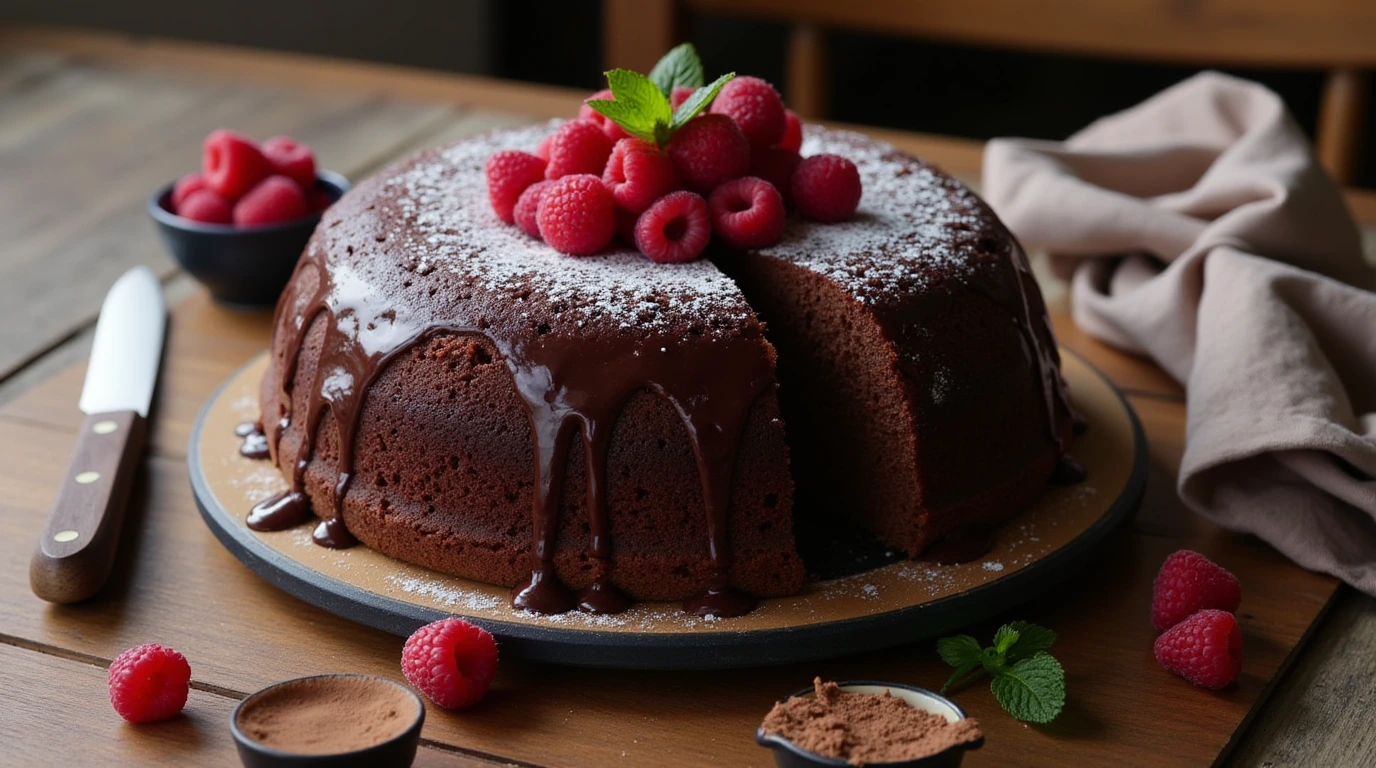Indulge in a rich, decadent dessert that’s not only delicious but also aligns with your health goals. Almond flour chocolate cake is a perfect choice for those who prefer a gluten-free treat without compromising flavor or texture. This cake is naturally moist, full of chocolatey goodness, and packed with the nutrients of almond flour, making it both indulgent and wholesome.
Why Almond Flour Chocolate Cake is Special
This chocolate cake isn’t just another gluten-free option; it’s a game-changer in healthy baking. Almond flour, made from finely ground blanched almonds, creates a dense, moist texture that complements the deep flavor of cocoa powder. Here’s why it stands out:
- Nutritional Benefits: Almond flour is rich in protein, fiber, and healthy fats, making it a nutrient-packed alternative to traditional flours.
- Dietary Flexibility: Perfect for those following gluten-free, keto, or paleo diets.
- Enhanced Flavor: The natural nuttiness of almond flour pairs beautifully with the chocolate, creating a deeper, more complex flavor.
For additional almond flour recipes, explore these almond flour coffee cake muffins, another delicious way to use this versatile ingredient.
Key Ingredients for Success
To make the best almond flour chocolate cake, focus on quality ingredients. Here’s what you’ll need:
- Almond Flour: Use superfine almond flour for the smoothest texture and optimal moisture.
- Cocoa Powder: Choose unsweetened, high-quality cocoa for a rich and bold chocolate flavor.
- Sweeteners: Coconut sugar, honey, or maple syrup work well as natural alternatives to refined sugar.
- Eggs: Provide structure and keep the cake moist.
- Butter or Coconut Oil: Adds richness and helps bind the ingredients together.
- Vanilla Extract: Enhances the overall flavor profile.
Optional Additions
- Chocolate Chips: For an extra hit of chocolate, mix some into the batter.
- Nuts: Chopped walnuts or pecans add crunch and texture.
- Espresso Powder: Intensifies the chocolate flavor.
To further elevate your baking game, check out these gluten-free baking recipes for inspiration.
Step-by-Step Guide to Perfection
1. Preparation
- Preheat your oven to 350°F (175°C).
- Grease a 9-inch round cake pan and line it with parchment paper for easy removal.
- Measure and sift almond flour and cocoa powder to eliminate lumps and ensure a smooth batter.
2. Mixing the Batter
- In a large bowl, combine the dry ingredients:
- 2 cups almond flour
- ½ cup cocoa powder
- 1 tsp baking powder
- ¼ tsp salt
- In another bowl, whisk together the wet ingredients:
- 3 large eggs
- ½ cup melted butter or coconut oil
- ¾ cup sweetener of choice
- 1 tsp vanilla extract
- Gradually fold the dry ingredients into the wet ingredients, mixing until just combined. Avoid overmixing to keep the batter light.
3. Baking
- Pour the batter into the prepared pan and smooth the top with a spatula.
- Bake for 25–30 minutes, or until a toothpick inserted in the center comes out clean.
- Let the cake cool in the pan for 10 minutes, then transfer it to a wire rack to cool completely.
Creative Variations
1. Double Chocolate Cake
Take the chocolate flavor to the next level by adding ½ cup of dark chocolate chips or chopped dark chocolate to the batter. This addition melts into the cake as it bakes, creating pockets of gooey chocolate. For even more indulgence, sprinkle extra chips on top before baking for a beautiful and delicious finish.
2. Keto-Friendly Version
For those on a keto diet, replace traditional sweeteners with erythritol, monk fruit sweetener, or a keto-friendly syrup. These substitutes keep the cake low in carbohydrates without sacrificing flavor. Pair this version with a dollop of unsweetened whipped cream or a sprinkle of cocoa powder for a satisfying low-carb dessert.
3. Vegan Option
Transform this cake into a vegan masterpiece by substituting eggs with flaxseed meal. Mix 1 tablespoon of flaxseed meal with 2.5 tablespoons of water per egg, let it sit for a few minutes until it forms a gel-like consistency, and use it as a direct replacement. Combine this with coconut oil instead of butter for a completely plant-based treat.
4. Layered Chocolate Cake

Turn this simple recipe into a show-stopping layered cake by slicing the cooled cake into two or even three layers. Spread each layer with your choice of fillings:
- Rich Ganache: Made with melted dark chocolate and coconut milk.
- Whipped Cream or Dairy-Free Frosting: Light and fluffy options to balance the rich cake.
- Fruit Preserves: Add a tart contrast to the chocolate’s sweetness.
Decorate the top with fresh berries, shaved chocolate, or edible flowers for an elegant touch.
5. Nutty Delight
Add chopped walnuts, pecans, or hazelnuts to the batter for a crunchy texture. Toast the nuts beforehand to enhance their flavor and provide a subtle smokiness that pairs beautifully with chocolate.
6. Spiced Chocolate Cake
Give your cake a unique twist by adding a pinch of cayenne pepper or ground cinnamon to the batter. The spices complement the chocolate and create a warm, aromatic flavor that’s perfect for winter gatherings.
7. Gluten-Free Cupcakes
Turn the batter into individual cupcakes by dividing it evenly into a lined muffin tin. Bake at 350°F for 18–20 minutes, or until a toothpick inserted into the center comes out clean. These mini versions are perfect for parties or portion-controlled desserts.
8. Mocha Chocolate Cake
Enhance the chocolate flavor with a hint of coffee. Add 1 teaspoon of espresso powder or substitute some of the liquid with strong brewed coffee. This mocha version is a sophisticated treat that pairs wonderfully with a latte or cappuccino.
Pair this cake with gluten-free zucchini bread to create a delightful dessert spread. Together, these options offer a balance of rich indulgence and wholesome goodness, making them a perfect combination for any occasion!
FAQs
1. Can I Replace Almond Flour with Other Flours?
Almond flour’s high fat content and fine texture give it unique baking properties, making direct substitution challenging. However, you can experiment with:
- Coconut Flour: Use ¼ the amount of almond flour and increase the liquid or eggs in the recipe. Coconut flour absorbs much more moisture.
- Oat Flour: Provides a similar texture but will not be as moist. Adjust liquids and baking time accordingly.
If substituting, expect differences in texture and flavor, as almond flour creates a distinct nuttiness and tenderness.
2. How Long Can I Store Almond Flour Chocolate Cake?
Proper storage ensures the cake retains its moisture and flavor:
- At Room Temperature: Store in an airtight container for up to 3 days, keeping it away from heat and direct sunlight.
- Refrigerated: Extend freshness by keeping it in the fridge for up to 7 days. Let it come to room temperature before serving for the best taste.
- Frozen: Slice the cake into individual portions, wrap each piece tightly in plastic wrap, and store in a freezer-safe bag or container. Thaw in the fridge or microwave for a quick treat. The cake can last up to 3 months in the freezer.
3. What Toppings Work Best?
Enhance the flavor of your almond flour chocolate cake with these topping ideas:
- Classic: Whipped cream or dairy-free coconut whipped cream for a light and airy contrast.
- Fruity: Fresh berries like strawberries, raspberries, or blueberries add a pop of color and natural sweetness.
- Rich and Decadent: A drizzle of melted chocolate, chocolate ganache, or caramel sauce.
- Simple and Elegant: A dusting of powdered sugar or cocoa powder for a classic finish.
Mix and match toppings to suit your taste or the occasion.
4. Why is My Cake Dense?
Common reasons for a dense almond flour cake include:
- Overmixing the Batter: Overmixing can cause the cake to lose its light texture. Mix until just combined.
- Using Almond Meal Instead of Almond Flour: Almond meal, made from unblanched almonds with skins, is coarser and less suitable for light cakes.
- Incorrect Measurements: Always measure almond flour precisely, preferably with a kitchen scale, as it packs more densely than traditional flour.
To achieve a fluffy texture, sift almond flour and avoid compacting it when measuring.
5. Can I Make This Cake Dairy-Free?
Yes! Substitute butter with coconut oil, dairy-free margarine, or a neutral-tasting oil like avocado oil. Pair it with a dairy-free frosting, such as whipped coconut cream, for a completely dairy-free dessert.
6. Can I Use Honey or Maple Syrup Instead of Sugar?
Absolutely! Both honey and maple syrup work well as natural sweeteners. However:
- Reduce the amount slightly to prevent the batter from becoming too liquid.
- Adjust the baking time, as cakes with liquid sweeteners may bake slightly faster.
7. How Do I Prevent My Cake from Sticking to the Pan?
To avoid sticking:
- Grease the pan generously with butter, coconut oil, or a non-stick spray.
- Line the bottom with parchment paper for easy removal.
- Allow the cake to cool before attempting to remove it from the pan.
8. Can I Add Other Flavors to This Cake?
Yes! Almond flour chocolate cake is versatile and pairs well with:
- Spices: Add a pinch of cinnamon or cardamom for warmth.
- Citrus Zest: Lemon or orange zest brightens the chocolate flavor.
- Extracts: Try almond or peppermint extract for a unique twist.
These FAQs address common questions and provide tips for achieving a perfect almond flour chocolate cake every time!
Tips for Perfect Almond Flour Baking
- Sift the Almond Flour: To avoid clumps and ensure a smooth batter.
- Use Room-Temperature Ingredients: Helps the batter mix evenly.
- Don’t Overmix: Keeps the cake light and prevents it from becoming dense.
- Use Parchment Paper: For easy removal without breaking the cake.
This almond flour chocolate cake recipe combines indulgence with nutrition, making it perfect for anyone who loves dessert but wants to maintain a healthy lifestyle. Bake this delicious treat today and enjoy the rich, nutty goodness of almond flour paired with the bold flavor of chocolate.

